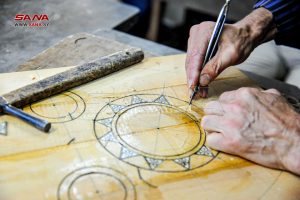Damascus, SANA- The Oud, Sultan of oriental musical instruments, is the beacon of authentic Tarab which has narrated stories of the Syrian art and translated the innovation of the Syrians who consider this instrument as an essential part of their intangible cultural heritage inherited from their ancestors and who have worked on developing the knowledge and skills related to it.
The quality of the Oud is measured by the quality of the wood of which it is made firstly, and it ends with the sweetness of the tunes. It is assumed that the name Oud is derived from the Arabic word “wood”.
The Oud industry entails skill and precision in making all of its parts starting from the strings to the peg box, where it is made of tonewoods (specific wood varieties endowed with tonal properties that make them good choices for use in stringed instruments) including walnut wood which is distinguished by its adaptability and gradient colors, as well as cypress wood.
Craftsmen decorate the Oud instrument using shapes inspired by their ancestral life and culture. The Oud is still present on many social and cultural occasions, and its music has also been able to move from one generation to another and evolve without renouncing its authenticity as a key element of groups’ and individuals’ intangible cultural heritage and its preservation means the preservation of a large part of their memory and the pillars of their cultural identity.
In order to find out more about the history of (the Oud) in the ancient times, SANA met with an expert in the maintenance of stringed instruments at the Higher Institute of Music, a researcher in ancient oriental instruments, Issa Michel Awad, who said that the Oud instrument dates back to the Akkadian era, about 3000 years BC, in the region between the Tigris and Euphrates rivers “Mesopotamia”, and that was confirmed by archaeologists through archaeological findings and murals (wall paintings).
The Oud was firstly used in Egypt in the New Kingdom in 1500 BC, and in Syria, the Oud appeared in the 15th century BC, while it spread in Palestine, the Arabian Peninsula and Greece in the fourth century BC, and then it became known in all Arab countries.
The Psalm of the Prophet Dawood who lived in 2300 BC provides a piece of evidence on the history of the Oud which is descended from an instrument called the lyre or harp as its verses mentioned the lyre; (Praise the LORD with harp: Sing unto him with the psaltery and an instrument of ten strings. Sing unto him a new song; Play skillfully with a shout of joy.)
Awad talked about the influence of the famous musician Ziryab on the Oud instrument in the Abbasid era, as he worked to reduce the weight of the instrument with its various shapes whether it is square, rectangular or circular. As for the strings of the oud at the time of Ziryab they were three, and after him, his student Ishaq al-Mawsili played a role in adding a fourth string to the oud. He gave each string a name, including “Zeer, Bam and Tak”.
Awad says that the Oud used to accompany the human voice, oriental Takht, or sessions and evening parties, but today it has different schools of “Damascene, Egyptian, Gulf, and others.”
The Oud instrument has been developed by modern schools, including musician Farid al-Atrash, who worked on adding a string to the instrument, as new horizons have been opened for music in its widest scope, and it has been no longer restricted to a singer or an oriental Takht, but rather it has spread to present compositions related to the Oud in dialogues that may be with the piano and the orchestra, says Awad.
According to the need of the composer or the player, additional strings are added to the Oud in order to reach what achieves a sound space for the musical notes.
Amongst the most famous Syrian Oud makers in the past, according to what Awad mentioned…is the Damascene Nahhat Family who reached a full stage of creativity in making the instrument. It is known that before 1900 BC, the measurements of the Oud were irregular, while the work of this family, including the sons and grandchildren was characterized by accuracy, durability, quality, and regularity of sizes, in addition to preserving the aesthetic aspect of the Oud.
Nahhat family introduced the mosaic craft to the Oud industry, using the natural colors of wood manufactured for the Oud, such as walnut, cypress, apricot, and roses, not to mention the sound hole that was characterized by infinite accuracy, and took different shapes while preserving the quality, strength, and durability of the instrument.
Awad reviewed the most famous Damascene Oud makers in the past, including Sinbat Badrositan, Abdul Majeed Hamwi, and the Qadmani brothers. In the middle stage, Qarbet Bedrosian, Mohammad Safi, and Ali Khalifa al-Jid were among the most famous Oud makers. In modern times, the grandson Ali Khalifa works in this profession, as he copied and developed the Damascene school.
In Aleppo, Michel Khawam and Jamil Kandalaft were among the elite Oud makers, as they made Oud from seashells, and presented it to Farid al-Atrash, and Naim Jurji Dalal, whose Oud was distinguished by its sound holes, while in Homs, Adel Adeeb and Mustafa al-Owair were among the most famous Oud makers.
Awad noted that the oud maker was not proficient in playing on it in the past, but today they have become professional musicians while being also skilled Oud makers, which paved the way for the development in Oud industry notably as the (manufacturer) has become better able to recognize mistakes and avoid them.
“The Damascene Oud is distinguished by its technique and sweet sound, and what distinguishes the sound of the Damascene oud is that it is based on grief, euphonious sound and warmth, as it is a soulful sound,” Awad concluded.
Prepared by: Rasha Mahfoud
Translated by: Ruaa al-Basri al-Jazaeri
 Syrian Arab News Agency S A N A
Syrian Arab News Agency S A N A










